
As the number of confirmed cases of COVID-19 in New York ramped up to 44 on Friday, parents and students faced the possibility of highly disruptive school closures — not to mention the potential cancellation of spring break trips. Already, two Manhattan prep schools have closed over fears of the novel coronavirus. The all-girls Spence School on the Upper East Side canceled classes for a “comprehensive sanitization of the entire campus,” according to its website, as did the all-boys Collegiate School on the Upper West Side. A family with children in both schools is reportedly being monitored for the novel coronavirus.
Rumors swirled in the private-school community that other schools are preparing to follow suit in the coming days and weeks. The decision to close Spence and Collegiate came after a Tuesday meeting between the headmasters of a number of independent schools, officials from the New York City Department of Health and Mental Hygiene, and the New York State Department of Health. Prep schools across the city are contemplating measures like canceling spring break trips, as Riverdale Country School in the Bronx did. Catholic schools in the city will require students traveling internationally to provide written medical clearance from their physicians before returning to school after spring break, even if they were traveling in countries with far fewer confirmed cases than the United States.
Public schools in the city remain open — but the city has implemented an isolation plan at each of the 1,800 schools. If a staff member or student develops symptoms, they are sent to an isolation room, where an adult wearing proper, sanitary protection equipment (like a gown and face shield) will supervise the student until arrangements are made to send the kid home.
Yeshiva University canceled classes until March 10 on two of its campuses, after one of its teachers tested positive for the virus, while two school districts in Westchester canceled classes after a number kids and parents showed symptoms of the virus. Schools across the country are considering closure as the number of confirmed cases nationwide continues to skyrocket. Most recently, the University of Washington told its 50,000 students that in-person classes would be suspended through the end of the quarter. Japan has closed its schools for about a month, and earlier this week Italy ordered all schools and universities closed until March 15.
Advocates for school closures argue that “closing schools can help prevent many thousands of illnesses and deaths,” as Dr. Howard Markel, of the University of Michigan’s Center for the History of Medicine, wrote in a Friday op-ed in the New York Times, making the case for shutting down schools. And New York City has closed public schools to stem the spread of a virus in the past, most recently during the H1N1 outbreak in 2009.
But, according to Michael Mulgrew, the president of the United Federation of Teachers union, closing a school is a last resort. “Are our children going to be safer at school or traveling around New York City on the subway?” Mulgrew said. “Which parents have access to day care and which parents don’t? In my conversations with City Hall and the chancellor, we have not taken school closings off the table, but it’s going to be dictated by the spread of the virus.”
On Thursday, Mulgrew told New York City Council members that more needed to be done to notify the families of students when a student or faculty member is showing symptoms of coronavirus. At least four teachers who had recently traveled to high-risk countries sought guidance from the union after they developed coronavirus-like symptoms this week. Three tested negative and one is in self-isolation.
Mayor de Blasio announced on Wednesday that schools would be deep cleaned twice a week and attendance records would not be a factor in middle- and high-school admissions next year, an unexpected ripple effect of the outbreak, according to Chalkbeat. Mulgrew also had concerns about the 137 schools across the city that do not have full-time school nurses. “We’re talking about over 70,000 kids who don’t have access to a health-care professional at school,” Mulgrew said, estimating that on any given day about 25 schools don’t have a medical professional in the building.






























